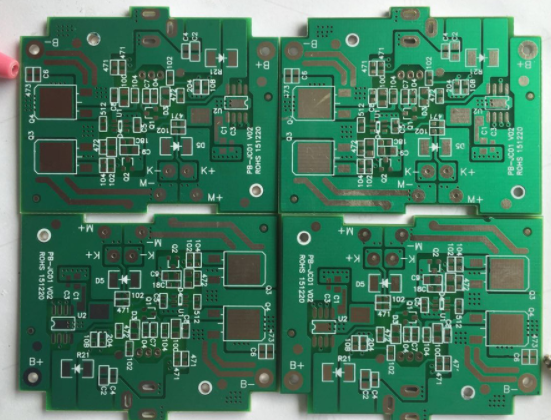The SMT chip processing and transmission system is a metal transfer mechanical claw placed on a roller. It supports the printed circuit board and moves it through the wave soldering area. The printed circuit board assembly is supported by the metal mechanical claw. Metal mechanical claws can be adjusted to meet the needs of printed circuit boards of different sizes and types, or manufactured according to special specifications and sizes.
(1) The structure of the transmission part of SMT patch processing.
It is mainly composed of bracket, chain, chain claw, motor, transmission gear, amplitude modulation mechanism, bracket height adjustment mechanism and so on. Among them, the amplitude modulation mechanism is composed of a fixed guide rail, an adjustable movable guide rail, an adjustment wheel, a transmission chain, a transmission gear, an adjustment thread shaft, a guide shaft, an bevel gear and a designated screw.
(2) The main function of the transmission part of SMT chip processing.
1. Complete the product conveying action.
2. Realize the change of the guide rail (chain claw) distance when the model is switched.

3. Change the angle between the SMT product and the wave crest surface when the SMT product is immersed in tin.
(3) The main technical requirements of the transmission part of SMT chip processing and its influence on wave soldering.
1. The level of the support. The bracket is the foundation of the transmission part, and its horizontal accuracy directly determines whether the fixed rail and the moving rail are level, thereby ensuring that the product conveyed by the chain claw can be immersed in the liquid surface at the same depth under the smooth state of the wave crest of the tin bath to prevent partial The occurrence of unimmersed tin and tin exposure.
2. The parallelism between the fixed guide rail and the adjustable movable guide rail. After the product is put into the tin furnace, the force exerted by the chain claws on both sides of the product should be consistent throughout the entire tin furnace, otherwise the product will be damaged (the front is loose and the rear is tight) and the substrate will be dropped (the front is tight and the rear is tight). The phenomenon of loosening) occurs, which will lead to the product scrapping, and in serious cases, it will lead to safety accidents and equipment accidents.
3. The straightness of the groove at the bottom of the chain claw. Because the product needs to complete the process of tin water coating, full preheating, primary tin immersion, secondary tin immersion, and cooling in the tin furnace, the length of the entire circulating chain is generally about 3m on one side, and the chain claws are fixed one by one. On the transmission chain, two parallel moving conveyor lines are formed to complete the conveying action of the product. The substrate is clamped on the groove at the bottom of the chain claws on both sides. If the chain claw is deformed or tilted to damage the straightness of the groove, the product will be tilted. The phenomenon of tin immersion occurs, and when it is serious, there will be major accidents such as parts terminals hanging on the tin pot, stopping, dropping the substrate, and overflowing the tin.
The accuracy of the above three parameters directly affects the stability of the immersion tin effect. Therefore, as equipment operators and maintenance personnel, they must also be regarded as the focus of their work in the normal operation and maintenance process.
(4) The technical requirements of SMT chip processing on the transmission system.
1. Smooth transmission, no material movement and vibration, and low noise.
2. The transmission speed is adjustable, and the transmission inclination range can be selected between 4°~8”.
3. Metal mechanical claws have stable chemical properties, will not erode, stick to tin, and will not chemically react with the flux under the repeated action of flux and high-temperature liquid solder, with good elasticity and stable clamping force. If metal mechanical claws are found to be stained with tin during the soldering process, it is usually caused by the low temperature of the tin wave, which can be solved by increasing the setting temperature of the tin wave.
4. Convenient loading and unloading, easy maintenance.
5. The structure is tight, and the overall size of the machine has little influence.
6. Good thermal stability and not easy to deform.
7. The clamping width can be easily adjusted according to the different width of the PCB circuit board.